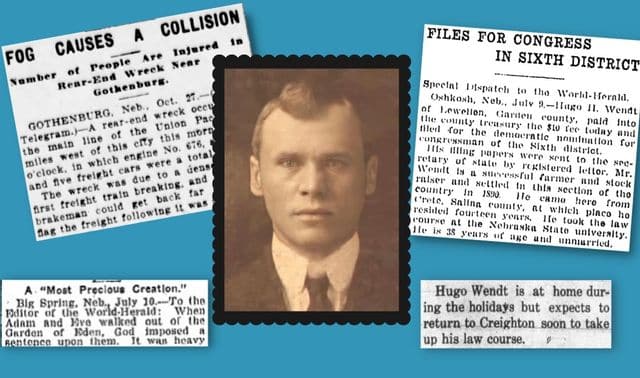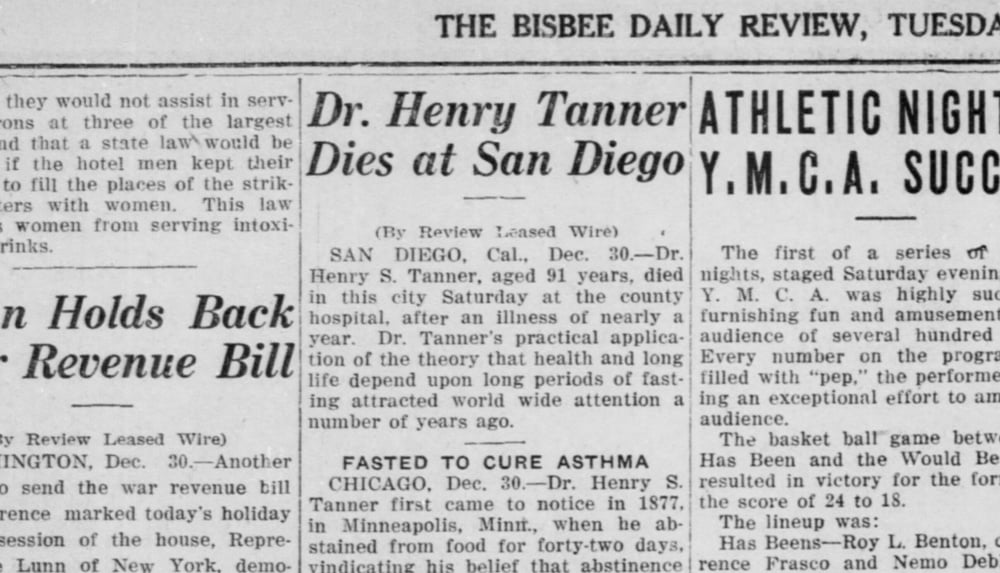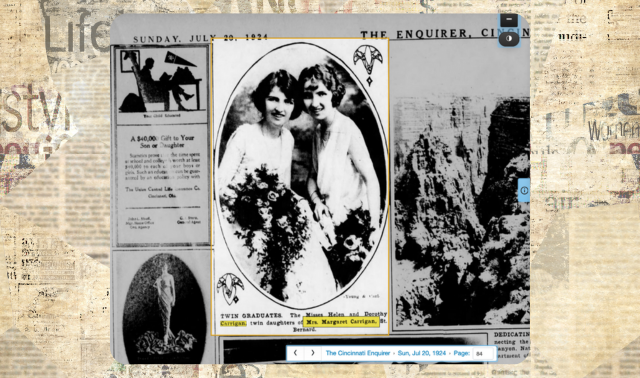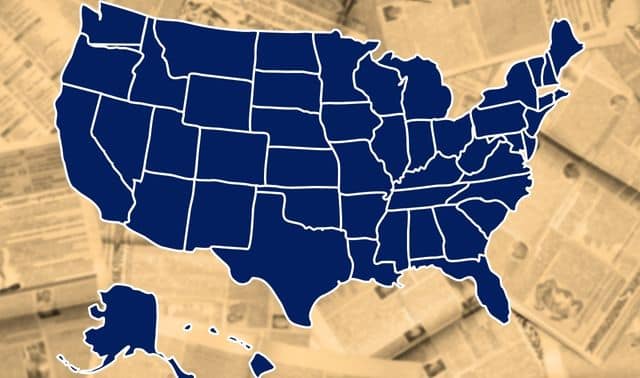Sign up for the Family Tree Newsletter! Plus, you’ll receive our 10 Essential Genealogy Research Forms PDF as a special thank you.
Get Your Free Genealogy Forms
"*" indicates required fields
Newspapers have long been among the richest (if sometimes underused) resources for genealogists. And today, technologies like optical character recognition and Ancestry.com’s state-by-state Stories and Events indexes make them easier than ever to search online.
Although you might first think of obituaries as the primary genealogical resource in newspapers, publications offer much more. Here are 6 other article types you might not have thought to search.
To illustrate how helpful they can be, I’ve included examples that chronicle the life of my great-grandfather, Edmund Muenchen.
1. Birth, Marriage and Anniversary Announcements
Deaths weren’t the only vital events to get coverage in papers. Local newspapers may have published notices about births, weddings, or milestone anniversaries, especially of notable people in the area. Announcements could include just the names of the people involved in a list or table. But they might have details like witnesses, place names, addresses and photos.
My great-grandparents Edmund and Hilda married 9 October 1929 in Newport, Ky., just across the river from their future home in Cincinnati. I have a digital copy of their county marriage license, but a notice in that day’s Cincinnati Post contains even more information:

Though a bit hard to read, the text names the church, wedding party (and their attire), and even what color flowers Hilda carried. It also notes Hilda’s dress was “ivory panne velvet, modeled after the Princess style with long skirt which touched the floor in back.” Not even photos would provide that level of detail!
I also found engagement or marriage announcements for several of Edmund and Hilda’s 10(!) children: Mary in 1948, Robert and William in 1955, Virginia in 1958, Lawrence and Susanne in 1961, John in 1964, and Paul in 1968. Many of them included a photo of the bride.
2. Social Columns
Newspapers functioned as the “social media” of the day, sharing a wide variety of news about recent or upcoming social events: parties, club and fraternal organization meetings, fundraisers like bake sales, and even details about family vacations.
Two years before they wed, Edmund and Hilda attended a surprise 25th wedding anniversary party for Hilda’s parents, hosted by the members of Hilda’s mother’s card club. A notice about the party ran in the Society column of The Kentucky Post and Times-Star, and listed several attendees:

3. Profiles and Feature Stories
The publications in your ancestors’ day didn’t just cover hard news (see below). They also shared human-interest stories and write-ups about notable residents.
In 1947, a Catholic conference hosted by a local university named the Muenchens “Family of the Year.” An issue of The Catholic Telegraph-Register the next year included an interview with Edmund:
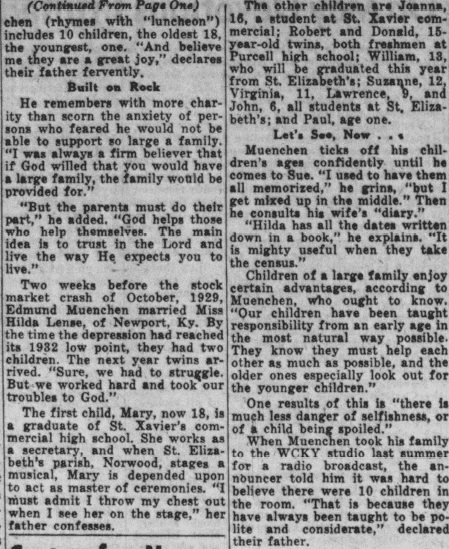
In addition to a photo of Edmund and information about his occupation and membership in fraternal organizations, the article names all 10 of his children and information about their occupations or grade levels.
Several quotes from Edmund give insight into his values, faith and sense of humor. One of my favorites: “I used to have [my kids’ ages] all memorized, but I get mixed up in the middle. Hilda has all the dates written down in a book.”
The conference and award were picked up by other publications, too. A write-up in the The Cincinnati Enquirer detailed who spoke at the conference. And The Tablet, a Catholic weekly paper published in Brooklyn, ran the story as “Threat to Family Told at Forum: Major Evils Outlined at Meeting in Cincinnati.”
4. Classifieds and Advertisements
Today’s large, glossy newspaper advertisements belie the kinds of notices that have historically run in newspapers. Patrons purchased whatever space they could afford to advertise goods and services or reach out to interested parties. Technological limitations meant ads were text-heavier than they are today, and (of course) usually printed in black and white.
Later in life, Edmund and his brothers owned a business called Knowlton Furniture. They took out several classifieds in the spring of 1957 to advertise the shop’s specials. This one from 19 April 1957 Cincinnati Enquirer offers three rooms’ worth of furniture for $425, half-off the retail price. The listing includes the business’ address and operating days. (Other entries specify hours.)
Even your non-entrepreneurial ancestors may have purchased (or been mentioned in) this section of a newspaper. A person may have sought to sell a dining room set they no longer needed, or hire someone to tend their lawn.
Recent immigrants sometimes placed “Information Wanted” advertisements, hoping to reconnect with relatives or friends who had already come to a community. And enslavers purchased ads for slaves who had escaped; after the controversial Fugitive Slave Act of 1850, even those living in northern states that had outlawed slavery were compelled by law to turn runaways back to their enslavers.
5. Court Listings
Newspapers also carried notices about recent or upcoming court cases, and the parties involved. Such a mention can point you to court records and give insight into your ancestor’s domestic, financial or even criminal history.
In 1958, The Cincinnati Enquirer lists Edmund as a party in four common pleas court cases. A Winifred Barrows sued him for $85,000 in damages, and an Emil Barrows for $26,500. The dispute was presumably related to Edmund’s furniture business, as Winifred and Emil sued Edmund both as a person and as a businessowner:
The listings include case numbers, which I can use to search court records to see if and how the cases were decided.
6. News Articles
Newspapers have been sharing “all the news that’s fit to print” long before 24-hour cable channels or the proliferation of social media and news websites. In fact, publishers of years past often had a broader definition of what was considered “newsworthy” than we do today, opening up all sorts of interesting research opportunities.
For example, your ancestor may have died in an unusual way that warranted coverage in the news section—maybe even in towns other than his own. Edmund died in 1960 of a heart attack while piloting his boat on a family vacation. The incident was on the cover of a Wednesday issue of The Lima News in Lima, Ohio; the city is about 125 miles from Edmund’s hometown of Cincinnati, but just 25 miles from where he died.
The article includes notes on the specifics of the incident: who saw Edmund last, conflicting reports that a grandchild was with him at the time, and what happened after he was discovered. It even shared that he’d recently seen a doctor about shoulder pain, a common warning sign of a heart attack.
Even if they don’t mention your ancestor specifically, timely articles in newspapers give you insight into the concerns of the day. The stories surrounding Edmund’s “Man Found Dead in Boat on Lake” are a snapshot of contemporary events that we’d think of as “hard news”:
- An update on the 1960 Democratic National Convention: “Demos May Pick Kennedy Tonight,” with notes on what the Ohio delegation planned to do
- A summary of recent tensions between the United States and the Soviet Union after the USSR shot down a US plane over international waters, just two months after the infamous U-2 crisis
- A notice that a Ford Motor workers’ strike in nearby Cleveland had been resolved
Related Reads
Last updated: March 2023






